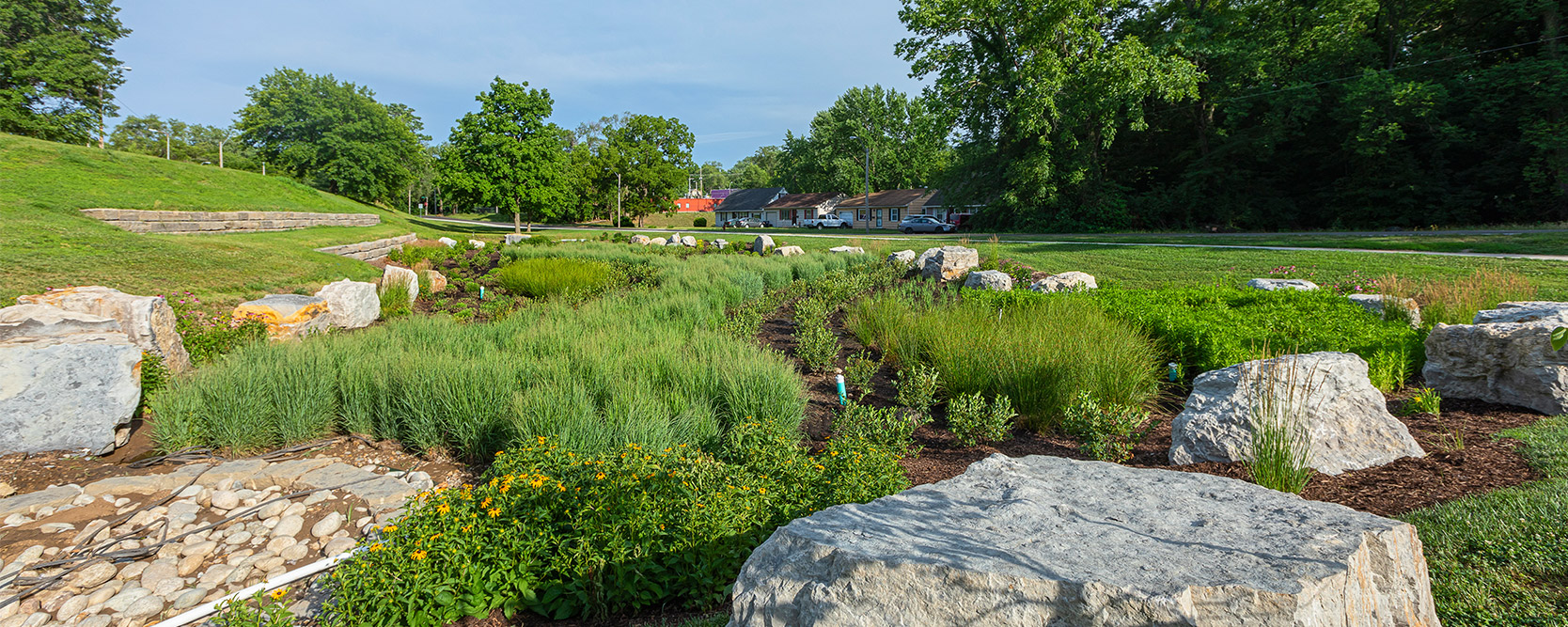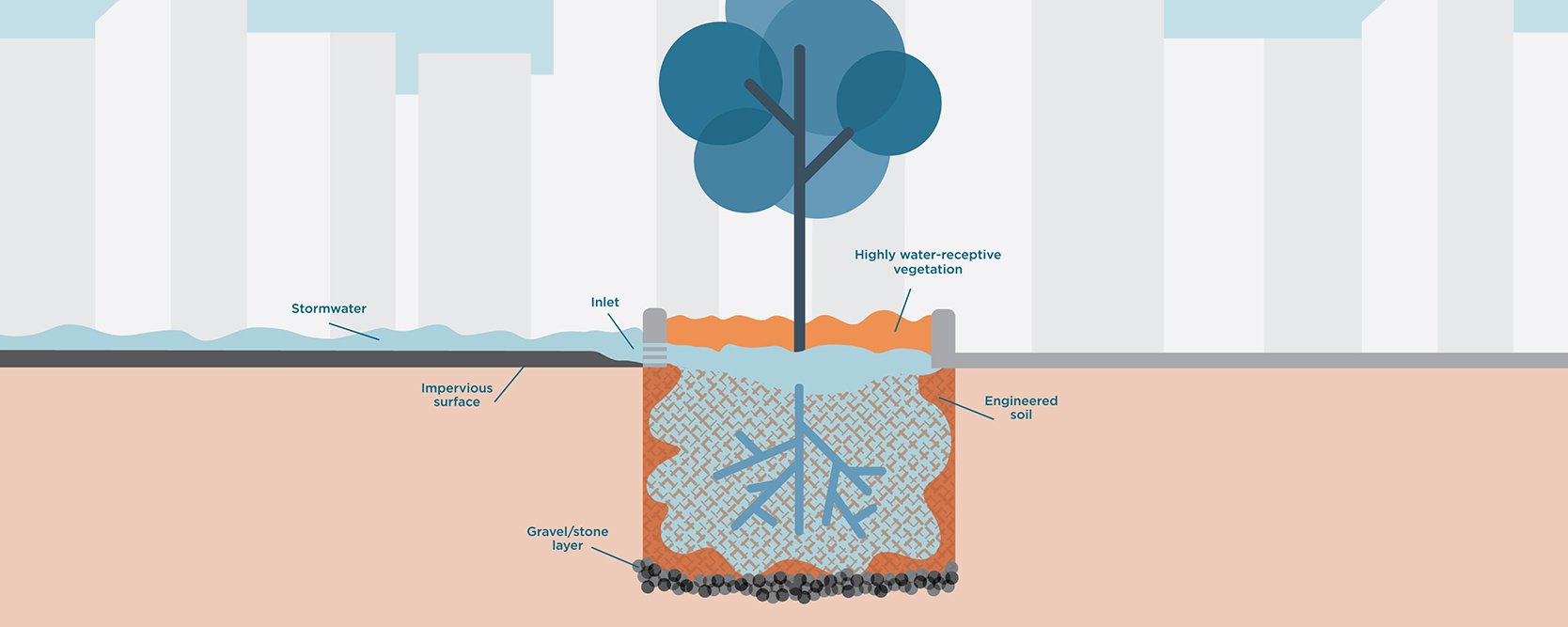
White Paper
Resilient Stormwater Management Begins With the Watershed, Not the Project
BY Brenda Macke, PE, and Andy Sauer, PE
Capture, control and convey — for decades, stormwater management has been focused on these basic goals. But a century of temporarily solving the same issues without addressing the bigger picture has demonstrated the need to think differently about stormwater solutions.


Why we need to change
The recent United Nations Global Environmental Outlook addressed a multitude of environmental challenges our planet faces — and cautioned that we’re running out of time to tackle them. Our watersheds are at a similar tipping point. The traditional, piece-by-piece stormwater approach is no match for a rapidly growing population, ongoing development and an increase in significant weather events.
Development has dramatically changed the natural landscape. Impermeable surfaces, including pavement and roofs, have replaced permeable soil and vegetation. These surfaces reduce infiltration of water into the ground and change how water and soil have moved through our environment over time. Water moves over impermeable surfaces faster than it does over vegetated surfaces, causing the stormwater to reach a stream quicker, thus eroding and changing the stream’s banks.
Rainfall events are also changing in number and extremity — and changes in how land is used often impact a stream’s capacity to handle stormwater volume, so there’s nowhere for this rainfall runoff to go. Some communities were originally built in floodplains, and others continue to encroach on this defined stormwater conveyance and storage, increasing the risk to buildings, infrastructure and public safety.
While we may not be able to control dramatic increases in severe weather events or development trends that show no signs of stopping, we can control our approach to stormwater solutions. What if we shifted our vision of stormwater to see it as a natural resource rather than as waste? What if we considered multiple benefit solutions that function for more than one hypothetical rainfall event? Can we create adaptive designs that better react to future climate change, land use changes or regulations?
Why the Traditional Approach Has Persisted
The goal of our current stormwater standards is to collect runoff from rain and snow, treat it as a waste product of urbanization and route it away from the built environment efficiently and affordably. It’s no wonder this traditional approach has persisted, because — in the eyes of many — it works, reducing flood risk to property and safeguarding the public by routing stormwater off roads and streets.
It’s a reactive but understandable response when city officials are expected to fix every problem as soon as possible, with fewer resources than ever to address them. Exacerbating the issue is a lack of awareness — from developers and property owners — of how water runs through a community. When homeowners see water in their basements, they don’t really care where it’s coming from and why. When developers change a green piece of land to a marketable office building, they’re often not thinking about what’s at the bottom of the hill.
In boardrooms, meeting rooms and living rooms across the country, there’s a general unfamiliarity with how water moves both over and under the ground, and how it can be controlled. Out of necessity, more holistic thinking about the causes of flooding takes a backseat to reactive needs — and the risk isn’t necessarily reduced but passed downstream. As those problems travel down the watershed, the solutions become more expensive and require a better understanding of how water continues to move over the land to lower points, no matter how much time or money is spent trying control it.
Disrupting this cycle is a challenge, requiring more comprehensive thinking, more time and sometimes more money. But change is necessary.

Shifting the Narrative and Approach
Some answers are already out there. A fresh approach to stormwater can balance performance and cost, reduce downstream impacts, adapt to climate change, integrate natural systems and increase the overall stormwater benefit. But disrupting the methods that have been the norm for a generation isn’t easy. The transition starts with education — for stormwater designers, city officials and the public.
Education tactics for stormwater designers
Paradigm shifts begin with questioning every element of each decision. Is this the best solution for the watershed, or the one we’ve always relied on for the project site? Does this solve the problem, or, is it a temporary fix? Does this move the risk downstream?
Change the perception of stormwater as a waste to stormwater as a natural resource. Historically, standards have focused on getting rid of excess water as quickly as possible. But when we consider if a project is beneficial to a river, lake or stream, a more holistic and lasting solution emerges.
Collaborate and brainstorm with regional colleagues across all technical disciplines that touch stormwater (planners, engineers, architects, landscape architects, etc.). A watershed pays no attention to city limits, so it will take a village, or several villages, coming together to effect real change. This collaboration must start with stormwater professionals before it can elevate to the civic sphere. And as stormwater professionals, we must observe stormwater through several lenses.
Become a proponent of emerging best practices as an integral piece of stormwater management, not an “add on” to check the box. Look for retention opportunities that integrate with the function of the project. Rain gardens, bioretention cells and pervious pavements mimic the natural hydrologic cycle, helping collect and control stormwater at or near the source. How can we make these solutions a focus of site development and reconstruction?
Education tactics for city officials
City officials are constantly being asked to do more with less. So, why not look at infrastructure solutions that tackle multiple objectives and bring community benefits while meeting a need? When one community asset — a road, for example — requires rebuilding, considering how to also improve other infrastructure pieces associated with the effort can be a fiscally beneficial approach.
Prioritize what the system needs most of the time over what it needs during extreme weather events, flipping the cost-benefit ratio around by making a path for stormwater excess rather than controlling it. Planning for more typical events instead of one peak flow can be a more cost-effective and resilient solution, allowing the same resources to be used with greater efficiency.
Recognize bigger isn’t always better. Stormwater systems are typically sized to handle large flooding events, so designers opt for the supersize solution. But from a pure capacity standpoint, historical analysis shows that — most of the time — only about 20% of that pipe size is needed.
Think in terms of shaping development rather than limiting it. Encouraging development around water in flood-prone areas versus attempting to out-design mother nature minimizes potential property damage. This approach may bring some hard decisions, such as buying a building or not allowing development on a site, but the results strengthen the community as a whole and create a beneficial connection between developer and civic goals.
Bring developers along as partners. Their goal is your goal: more assurances about flood protection and a property that’s desirable to tenants. Incorporating sustainable infrastructure practices can even help build their business by attracting green-minded tenants. Adopting standards such as cluster development and narrower street widths can minimize the development footprint. In some areas of the country, utility fees are high enough to provide a developer motivation to seek out a more efficient stormwater control system for a reduced bill.
Education tactics for the general public
Take it back to basics. A general grasp of how water moves on and under the surface can build a stronger foundation when changes to the usual approach are proposed.
Generate conversation about the cost of infrastructure — roads, stormwater management, clean drinking water and more — to the public. People often assume there’s always budget to provide for these services, or they don’t think about it at all. But, in reality, many communities are struggling to keep up with infrastructure needs.
Use every communications tool at your disposal. A simple marble run can demonstrate the basics of stormwater design. A handful of marbles — representing excess water — can spark understanding when the marbles flow smoothly down circular sections, where they can spread out, but clog on straight sections. High-tech tools are effective too; a 2D computer model can provide an excellent understanding of how water flows.
Make new solutions relevant. Homeowners may show more patience for temporary flooding issues when they realize a broader solution will address their problem — and their neighbors’ problems — more permanently and cost-effectively.
Tap into the media, especially weather professionals. Intense rain events (and the causes behind them) always draw significant viewership. What if, during the next potential flood event, a news professional was equipped to talk about the city’s collection system and why it’s sometimes overwhelmed?

Big Thinking With Targeted Solutions
When facing the need for big change, it’s tempting to focus only on big solutions. But those big solutions aren’t feasible for many, or most, communities. We’re shifting an entrenched way of thinking that’s a century in the making, and change won’t happen overnight. But that doesn’t mean we should shy away from making the effort. Some communities are advancing progress in ways both big and small.
Uniting Civic Leadership: Watersheds cross many jurisdictions, and it can be challenging to unite civic leaders under a comprehensive strategy. But it’s not impossible — and when it happens, it creates a groundswell for real change. Washington, D.C., is addressing the significant issue of existing development in floodplains, announcing a goal of retrofitting or removing all of its flood-prone buildings by 2050. It’s part of a broader plan that sets goals for coping with increasingly severe weather events projected to come with the major climate stresses.
Budget-Friendly Master Planning: In Grandview, Missouri, city officials were focused on updating a 30-year-old stormwater master plan, after a summer of significant rainfall caused severe flooding. They needed a modern approach that could better communicate how stormwater moved through the city, but a capital-intensive plan wasn’t a realistic option. The solution was a suite of tools, developed in a geodatabase framework, that provided real-time analysis of stormwater issues using current city data. Layering these tools together greatly enhances the knowledge base for city engineers, creating an evolving “master plan” that allows them to better manage stormwater on a day-to-day basis and more accurately address current and potential drainage issues.
Stormwater as a Resource: Lake Michigan is one of Milwaukee’s greatest treasures — and city officials are using stormwater solutions to help protect it. Under the Milwaukee Common Council’s Green Infrastructure Plan, all large developments and redevelopments must capture the first half inch of rainfall with green infrastructure. The Milwaukee Metropolitan Sewerage District has also focused on green infrastructure to transform its approach to managing stormwater in sanitary and combined stormwater/sanitary pipes. By 2035, the organization hopes to create enough green infrastructure in its service area in Wisconsin to capture 740 million gallons of water every time it rains.
A Higher Level of Stormwater Design
A higher level of stormwater design is waiting for the communities that can put the pieces together to achieve it — starting with education then moving forward to creative strategy and solid implementation. Adaptive stormwater design standards that view stormwater as a resource and consider the entire watershed can halt the practice of passing the problem downstream, offering more resilient solutions that provide greater community benefits.
Redirecting an entire industry onto a more promising, progressive path won’t be easy, and it will take time and effort. Education is the starting point on the path to progress, and starting these conversations among stormwater designers, city officials and the community will bear fruit. In the end, the effort will be worth it for our watersheds — and, frankly, our communities and environment demand it.
✖
READ White Paper
✖
SUBSCRIBE
✖

